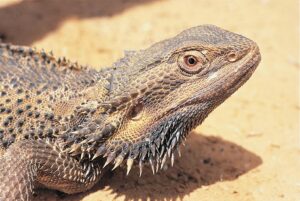Ever caught yourself wondering, “What’s the deal with how do bearded dragons sleep?” Well, prepare for a wild ride into the sleepy realm of these cool reptiles. They’ve got bedtime stories that involve snug burrows and bizarre sleep poses that’ll make you raise an eyebrow.
Bearded dragons may find cozy spots to snooze, like under rocks, inside hideouts, or even burrowed in the substrate. Sometimes, they’ll sleep in awkwardly cute positions, resembling a yoga pose gone reptilian.
Interestingly, they can also display a form of brumation, which is like a cold-blooded version of hibernation. During this period, typically in colder months, their activity levels drop, and they may sleep more.
How do bearded dragons sleep?

Bearded dragons, like many reptiles, have specific sleep patterns and behaviors. Here are some aspects of how bearded dragons sleep:
- Nocturnal Behavior: Bearded dragons are diurnal, which means they are most active during the day and sleep at night. They generally follow a natural day-night cycle.
- Sleeping Spots: Bearded dragons usually have preferred sleeping spots within their enclosure. These spots might include hiding places, basking areas, or comfortable elevated surfaces.
- Sleeping Positions: Bearded dragons may sleep in various positions. They might stretch out flat on their bellies, curl up, or tuck their legs under their bodies. The exact position can depend on factors like the dragon’s age, health, and personal preferences.
- Eyes Closed: When bearded dragons sleep, they often close their eyes. However, this can vary, and some may sleep with their eyes partially open.
- Reduced Activity: As they prepare for sleep, bearded dragons typically reduce their activity level. They may become less responsive to external stimuli and move less.
- Temperature Regulation: Bearded dragons are ectothermic, meaning they rely on external heat sources to regulate their body temperature. During sleep, they may move to cooler areas within their enclosure if they need to cool down or stay in warmer areas for comfort.
It’s essential to provide a proper environment for your bearded dragon to ensure healthy sleep patterns. This includes maintaining the appropriate temperature gradient within their enclosure, offering hiding spots, and providing a consistent day-night cycle. Additionally, avoid disturbing your bearded dragon during its sleep cycle to allow it to rest and maintain a healthy lifestyle.
Bearded Dragon Sleep Patterns
Bearded dragons, like many reptiles, exhibit specific sleep patterns influenced by their natural behaviors and environment. Here are some key aspects of bearded dragon sleep patterns:
- Diurnal Nature: Bearded dragons are diurnal, meaning they are primarily active during the day. In their natural habitat, they bask in the sun to regulate their body temperature and engage in activities such as hunting and exploring during daylight hours.
- Nighttime Sleep: Bearded dragons typically sleep at night, and their activity levels decrease. During this time, they may find a secure and comfortable spot in their enclosure to rest.
- Basking and Sleeping Areas: Bearded dragons often have specific areas designated for basking and sleeping. The basking area is where they can absorb heat and UVB light, crucial for their overall health. The sleeping area is usually a cooler and sheltered spot where they can rest without being exposed to excessive heat.
- Temperature Influence: Temperature plays a significant role in a bearded dragon’s sleep patterns. They require a thermal gradient in their enclosure, with a basking spot that reaches around 95-110°F (35-43°C) and a cooler area around 75-85°F (24-29°C). The availability of these temperature ranges allows them to regulate their body temperature and choose appropriate spots for different activities, including sleep.
- Sleeping Positions: Bearded dragons may adopt various sleeping positions. They might stretch out flat, curl up, or rest with their legs tucked under their bodies. These positions can vary among individuals and may change as the dragon grows or ages.
- Eye Closure: Bearded dragons often close their eyes when they sleep, but some individuals may sleep with their eyes partially open. The degree of eye closure can depend on the dragon’s comfort level and environment.
It’s crucial for bearded dragon owners to provide a well-designed enclosure with proper lighting, heating, and hiding spots to support their natural sleep patterns. Maintaining a consistent day-night cycle and ensuring a comfortable environment contribute to the overall well-being of these reptiles.
Temperature requirements for optimal sleep


